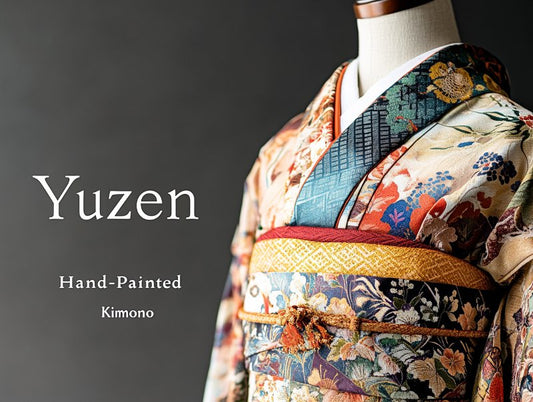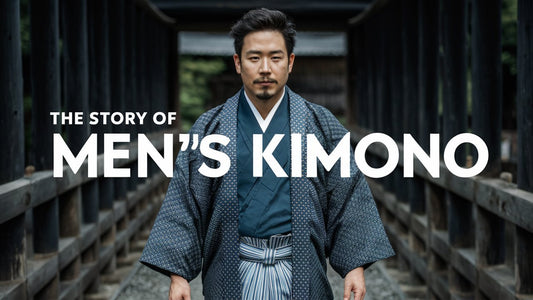
From Heirloom to Waste: The Fate of Japan's Traditional Kimonos
Share
The traditional Japanese kimono has a rich cultural heritage that dates back centuries. These elegant and intricately designed garments have long been revered for their symbolism, artistry, and craftsmanship. However, in recent years, the fate of Japan's traditional kimonos has taken a troubling turn. With the rise of disposable fashion and the decline of traditional craftsmanship, kimonos are now facing an uncertain future, with many being discarded as waste. In this article, we will explore the cultural significance of kimonos, the shift from heirloom to disposable fashion, the environmental consequences of kimono waste, the socio-economic implications of kimono decline, and the efforts being made to preserve and revive kimono tradition.
Understanding the Cultural Significance of Kimonos
The historical roots of kimonos can be traced back to ancient Japan. These garments have played a central role in Japanese culture, representing not only fashion but also tradition, social status, and historical identity. The intricate designs and patterns found on kimonos often reflect the natural world, with motifs such as flowers, birds, and landscapes. Kimonos have also been used to convey messages and serve as a form of self-expression for individuals. Furthermore, kimonos are closely associated with important Japanese ceremonies and events, such as weddings and tea ceremonies, where they are still worn today.
The Historical Roots of Kimonos
The history of kimonos can be traced back to the Nara period (710-794), where they were initially worn as undergarments by the aristocracy. Over time, kimonos evolved into the distinctive outerwear we recognize today, with various styles and designs emerging during different periods. During the Heian period (794-1185), kimonos became more elaborate and were adorned with intricate patterns and vibrant colors. The Edo period (1603-1868) marked a golden age for kimono-making, as it became a highly regarded art form. The artistry and craftsmanship involved in creating kimonos reached its peak during this period, with skilled artisans dedicating their lives to perfecting the intricate techniques.
Symbolism and Artistry in Kimono Design
Every aspect of a kimono, from its choice of fabric to its color and pattern, holds symbolic meaning. For example, red kimonos are often worn during celebrations, as red is considered a lucky color in Japanese culture. The symbolism extends to the patterns and motifs found on kimonos as well. Cherry blossoms, for instance, represent the transient nature of life, while cranes symbolize longevity and good fortune. The artistry involved in creating a kimono is truly remarkable. The process begins with the selection of the fabric, which can range from silk to cotton, depending on the occasion and season. Then, skilled artisans meticulously hand-sew, dye, and embroider the fabric, employing techniques that have been passed down through generations. It is not uncommon for a single kimono to take months, or even years, to complete.
Furthermore, the artistry of kimono-making extends beyond the garment itself. The obi, a wide belt worn with the kimono we use in our leather obi bags, is often a work of art in its own right. It is intricately woven or embroidered with elaborate designs, adding an extra layer of beauty to the overall ensemble. The obi serves both a functional and aesthetic purpose, as it helps to secure the kimono and enhance the wearer's silhouette.
In conclusion, kimonos are not simply garments; they are a tangible representation of Japan's rich cultural heritage. From their historical roots to the symbolism and artistry embedded in their design, kimonos continue to captivate and inspire people around the world. Whether worn for special occasions or displayed as works of art, kimonos are a testament to the enduring beauty and significance of Japanese culture.
The Shift from Heirloom to Disposable Fashion
While kimonos have a long history as cherished heirlooms, the modern fashion landscape has brought significant changes. One of the factors contributing to the decline of traditional kimonos is the influence of Western fashion trends. As Western-style clothing became increasingly popular in Japan, traditional kimonos started to lose their appeal among younger generations. The rise of fast fashion, with its emphasis on cheap and mass-produced clothing, further marginalized the traditional kimono industry.
The Influence of Western Fashion Trends
With the influx of Western-style clothing in Japan, there has been a shift in societal perceptions of what is considered fashionable and trendy. Younger generations, influenced by global fashion trends, often view kimonos as outdated or impractical for everyday wear. The Western concept of individuality and self-expression has also contributed to the decline of kimonos, as many individuals opt for more personalized and modern fashion choices.
However, it is important to note that the influence of Western fashion trends is not solely responsible for the decline of traditional kimonos. While Western fashion has undoubtedly played a role in shaping the preferences of younger generations, it is also essential to recognize the cultural and historical significance of kimonos. These garments are not just pieces of clothing; they are a reflection of Japan's rich heritage and craftsmanship.
The Impact of Fast Fashion on Kimono Production
The rise of fast fashion has had a detrimental impact on traditional kimono production and craftsmanship. Fast fashion brands prioritize quick and cost-effective production, often relying on synthetic materials and low-quality manufacturing processes. This approach contrasts with the time-intensive and artful techniques used in creating traditional kimonos. As a result, many traditional artisans struggle to compete with the lower-priced, mass-produced alternatives in the market.
Moreover, the disposable nature of fast fashion has led to a decrease in the appreciation for quality and longevity in clothing. Kimonos, with their intricate designs and meticulous craftsmanship, are meant to be treasured and passed down through generations. However, the fast fashion industry promotes a culture of disposability, where clothing is seen as disposable commodities rather than valuable pieces of art.
Despite these challenges, there is a growing movement to revive the traditional kimono industry and promote sustainable fashion practices. Designers and artisans are finding innovative ways to blend traditional techniques with contemporary designs, appealing to a wider audience. By highlighting the cultural significance and environmental impact of fast fashion, there is hope for a renewed appreciation for the beauty and craftsmanship of kimonos.
The Environmental Consequences of Kimono Waste
The shift towards disposable fashion is not only affecting the cultural significance of kimonos but also contributing to significant environmental consequences. The problem lies in the materials used in modern kimonos, which often include synthetic fibers that are non-biodegradable and difficult to recycle.
The Problem of Non-Biodegradable Kimono Materials
Many modern kimonos are made from synthetic fabrics such as polyester, nylon, and acrylic. These materials can take hundreds of years to break down in the environment, leading to long-term pollution. Additionally, the production of these materials involves the use of fossil fuels, further contributing to greenhouse gas emissions and climate change.
The Carbon Footprint of Kimono Manufacturing
The manufacturing process of kimonos, especially those produced on a mass scale, can contribute to a significant carbon footprint. From the production of the fabrics to the transportation and packaging of the final product, each step in the supply chain has an environmental impact. The reliance on energy-intensive production methods and the high water usage in dyeing fabrics further exacerbate the ecological footprint of modern kimono manufacturing.
The Socio-Economic Implications of Kimono Decline
The decline of kimonos not only affects cultural traditions but also has far-reaching socio-economic implications. Artisans who have dedicated their lives to mastering the craft of kimono-making are facing dwindling demand and struggling to pass down their skills to future generations.
The Effect on Traditional Kimono Artisans
Many traditional kimono artisans operate small family businesses that have been passed down through generations. These artisans face increasing financial challenges as demand for traditional kimonos declines. Some have been forced to transition into making more affordable, modern-style kimonos or seek employment outside of the traditional kimono industry altogether. This loss of expertise and craftsmanship has profound cultural consequences.
The Changing Perception of Kimonos in Japanese Society
Kimonos were once a symbol of prestige and social status in Japanese society. However, as cultural norms and fashion preferences shift, the perception of kimonos has changed. They are becoming viewed more as ceremonial attire rather than part of everyday wardrobes. This shift in perception has led to a decline in kimono rental services and a decrease in the number of individuals purchasing traditional kimonos.
Efforts to Preserve and Revive Kimono Tradition
Despite the challenges facing the traditional kimono industry, there are ongoing efforts to preserve and revive this cultural treasure. These efforts involve sustainable and ethical practices, education, and innovation within the industry.
Sustainable and Ethical Kimono Production
Some artisans and designers are embracing sustainable practices by using eco-friendly materials, such as organic cotton and natural dyes. By prioritizing quality over quantity, these ethical producers aim to create kimonos that are not only beautiful but also environmentally conscious. Additionally, initiatives focusing on the revival of traditional dyeing and weaving techniques are being supported to ensure the preservation of traditional craftsmanship.
Read more about how we at Kimono Koi strive to ethically and sustainably preserve these kimonos
The Role of Education in Kimono Preservation
Education plays a crucial role in preserving kimono tradition. Schools, cultural organizations, and even museums are offering courses and workshops to educate younger generations about the cultural significance and craftsmanship behind kimonos. By instilling an appreciation and understanding of kimonos, these efforts contribute to the sustainable future of this revered art form.
In conclusion, the fate of Japan's traditional kimonos hangs in the balance. The decline of kimonos as heirlooms and the rise of disposable fashion has led to environmental consequences and socio-economic challenges. However, through sustainable practices, education, and a renewed appreciation for traditional craftsmanship, there is hope for the preservation and revival of this cultural treasure. It is essential that we recognize the cultural significance of kimonos and support initiatives that promote their continued existence in a world that increasingly values fast fashion and disposability.


